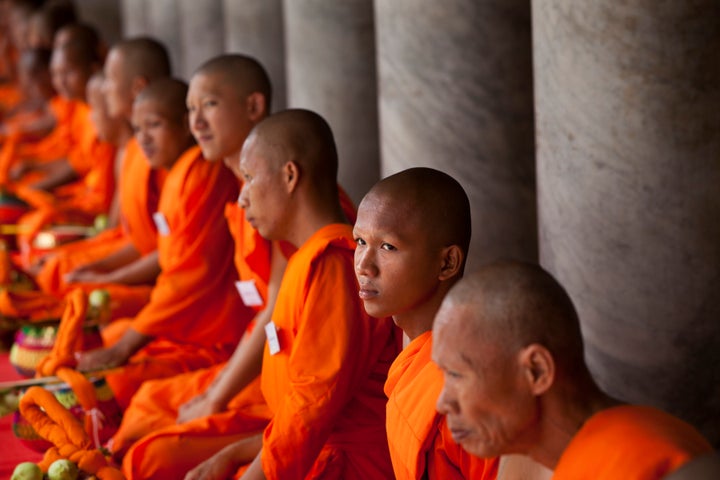
A few years ago, a Buddhist novice monk, Han Raksachit, was arrested after he released a video tape of himself piercing, bleeding, roasting, chanting and collecting the drippings from a nearly full-term baby's corpse at Nong Rakam Monastery in Saraburi Province (central Thailand). These drippings, which he called ya sane (lust medicine), he sold to visitors. Although he was forced from the monastery and arrested, he did not serve jail time and was arrested again in 2005 for tricking several women into sexual acts and defrauding them of money in exchange for dubious claims that he could help them attract their true loves. He is serving time now on 23 counts of rape.
More recently, in late 2010, authorities discovered 348 corpses of aborted fetuses being held in plastic bags in a Buddhist monastery. They were bought from five different abortion clinics, supposedly to sell to magicians and amulet dealers. This was not a rural monastery on the border of Cambodia or Laos, but a monastery in Bangkok -- Wat Phai Ngoen. Later reports in several Thai news outlets spoke of the hundreds of people who were visiting the monastery after the discovery of the bodies to chant for the deceased foetuses. Some also came to inquire about the availability of the corpses for ritual use.
Thailand is well-known as a tourist paradise, a land rich in exotic flora and silk. It is also known as the most Buddhist country on earth with almost 94% of the country's 65 million people self-identifying as Buddhist. There are 34,000 Buddhist monasteries and over 300,000 monks residing in the country. However, Thai Buddhist practices, especially those involving the magical uses of corpses and protective amulets, as well as the pervasive Thai propitiation of ghosts, hell-beings and protective spectral children has rarely been investigated in any serious way. With the rise in popularity of Thai/Khom protective tattoos, most notably inspired by Angelina Jolie, Apichatpong Weerasethakul's top prize at the Cannes Film Festival for his Thai religion-themed movie and monks filmed near recent bloody clashes on the streets of Bangkok in last spring's democracy protests, the less savory side of Thai religion has been exposed to the outside world.
While ritual practices, sometimes involving aborted fetuses might seem strange or even reprehensible to a person not familiar with Thai Buddhism, they are actually not that shocking in Thailand. While the cases above are extreme and offended even Thai practitioners of Buddhism, less-severe, but related practices can be traced back centuries and are commonly known by many devout Buddhists. In fact, ritual practices to either enlist the power of spiritual denizens or protect against the curses of human rivals are employed by the country's leading politicians and power-brokers. The former Prime Minister Taksin Shinawatra was rumored to have performed secret magical rituals to ensure his shaky political fortunes in 2006 right before he was forcibly removed from office by a political movement led in part by Sondhi Limthongkul. In turn, Sondhi has performed protective rituals to guarantee his political fortunes after a series of bloody street battles between the his supporters and the government in Bangkok in the Fall of 2008. Other public figures like Thai film stars like Sorapong Chartree commissioned a huge 65 foot tall statue of a nineteenth century monk who as famous for making protective amulets and holy water and the famous monk Luang Phu Kasem inspired the construction of one of the largest Buddha statues in the world, as well as a hell theme-park (suan narok) to educate children about the the various levels of hell.
The Thai protective amulet industry is worth about 300 million USD per year. There are thousands of articles in popular amulet collector's magazines about the value and beauty of these small objects. There is a regular section in the popular Thai language newspaper, Thai Rath, called "Sanam Phra" which features new amulets on the market, stories of their production and occasionally a miracle story about how an amulet saved a person from drowning or helped her business. Some amulets have sold for as much as 1.75 million USD. However, there are many amulets that cost as little as 10 cents. These amulets, albeit rarely, can be made more powerful with the addition of "corpse fluid" (nam man phrai) from aborted fetuses or freshly deceased adults.
In my new book, "The Lovelorn Ghost and the Magical Monk: Practicing Buddhism in Modern Thailand" (Columbia University Press, 2011), I go beyond studies of Buddhist meditation, ethics, and philosophy in order to provide a historical background to many of today's Thai Buddhist practices. I provide a detailed, but hopefully accessible, analysis of the amulet trade, the use of protective tattoos, the rise of Thai horror films, the chanting of protective incantations, the popularity of ghost stories and the work of well-known Buddhist monks, saints and magicians. Even though Thai Buddhism presents itself (and has been so designated by foreign scholars and Western Buddhist enthusiasts) as normative, traditional and exceedingly well-behaved, I argue throughout that rather than hidden aspects of an otherwise orthodox and peaceful Thai Buddhism, these magical and protective rituals and stories are part of the Thai religious mainstream. If we are going to talk in useful ways about Thai culture, if we are going to learn from the various Thai ways of being Buddhist, then it is more accurate to look at what complex technologies people actually employ to solve problems -- the practical (and sometimes seemingly impractical) technologies of astrology, healing, protection, prognostication, precepts, and the like. In this way, I hope to offer a solid background to what a visitor to Thailand, whether she is a scholar of Buddhism or an engaged tourist, will actually see, smell, and hear in a monastery -- even if what we witness makes us want to run it the opposite direction.